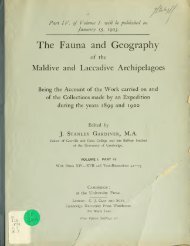- Page 1 and 2: BOBP / MAG / 25
- Page 3 and 4: CONTENTS Foreword and Acknowledgeme
- Page 5: FOREWORD The Bay of Bengal Programm
- Page 8: viii
- Page 13 and 14: xiii
- Page 16 and 17: INTRODUCTION The first edition of t
- Page 18 and 19: The Maldives has gained a reputatio
- Page 22 and 23: Mustelus manazo Bleeker, 1854 Engli
- Page 24 and 25: Carcharhinus albimarginatus (Rüppe
- Page 26 and 27: Carcharhinus amblyrhynchos (Bleeker
- Page 28 and 29: Carcharhinus limbatus (Valenciennes
- Page 30 and 31: Carcharhinus melanopterus (Qouy and
- Page 32 and 33: Galeocerdo cuvier (Peron and LeSueu
- Page 34 and 35: Negaprion acutidens (Rüppell, 1837
- Page 36 and 37: Sphyrna lewini (Griffith and Smith,
- Page 38 and 39: Odontaspis ferox (Risso, 1810) Engl
- Page 40 and 41: Alopias vulpinus (Bonnaterre, 1788)
- Page 42 and 43: Heptranchias perlo (Bonnaterre, 178
- Page 44 and 45: Dalatias licha (Bonnaterre, 1788) E
- Page 46 and 47: Herklotsichthys quadrimaculatus (R
- Page 48 and 49: Spratelloides gracilis (Temminck an
- Page 50 and 51: Alepisaurus ferox Lowe, 1833 Englis
- Page 52 and 53: Antennarius commersonii (Latreille,
- Page 54 and 55: Atherinomorus lacunosus (Forster, 1
- Page 56 and 57: Exocoetus monocirrhus Richardson, 1
- Page 58 and 59: Myripristis adusta Bleeker, 1853 En
- Page 60 and 61: Myripristis kuntee Cuvier, 1831 Eng
- Page 62 and 63: Myripristis murdjan (Forsskål, 177
- Page 64 and 65: Myripristis violacea Bleeker, 1851
- Page 66 and 67: Neoniphon aurolineatus (Liénard, 1
- Page 68 and 69: Neoniphon sammara (Forsskål, 1775)
- Page 70 and 71:
Sargocentron diadema (Lacepède, 18
- Page 72 and 73:
Sargocentron spiniferum (Forsskål,
- Page 74 and 75:
Sargocentron violaceum (Bleeker, 18
- Page 76 and 77:
Doryrhamphus excisus excisus Kaup,
- Page 78 and 79:
Fistularia commersonii Rüppell, 18
- Page 80 and 81:
Dendrochirus zebra (Cuvier, 1829) E
- Page 82 and 83:
Pterois radiata Cuvier, 1829 Englis
- Page 84 and 85:
Anyperodon leucogrammicus (Valencie
- Page 86 and 87:
Cephalopholis aurantia (Valencienne
- Page 88 and 89:
Cephalopholis miniata (Forsskål, 1
- Page 90 and 91:
Cephalopholis sonnerati (Valencienn
- Page 92 and 93:
Cephalopholis urodeta (Schneider, 1
- Page 94 and 95:
Epinephelus areolatus (Forsskål, 1
- Page 96 and 97:
Epinephelus chlorostigma (Valencien
- Page 98 and 99:
Epinephelus flavocaeruleus (Lacepè
- Page 100 and 101:
Epinephelus lanceolatus (Bloch, 179
- Page 102 and 103:
Epinephelus macrospilos (Bleeker, 1
- Page 104 and 105:
Epinephelus miliaris (Valenciennes,
- Page 106 and 107:
Epinephelus multinotatus (Peters, 1
- Page 108 and 109:
Epinephelus ongus (Bloch, 1790) Eng
- Page 110 and 111:
Epinephelus retouti Bleeker, 1868 E
- Page 112 and 113:
Epinephelus tauvina (Forsskål, 177
- Page 114 and 115:
Grammistes sexlineatus (Thunberg, 1
- Page 116 and 117:
Plectropomus areolatus (Rüppell, 1
- Page 118 and 119:
Plectropomus pessuliferus Fowler, 1
- Page 120 and 121:
Pseudanthias cooperi (Regan, 1902)
- Page 122 and 123:
Pseudanthias squamipinnis (Peters,
- Page 124 and 125:
Variola louti (Forsskål, 1775) 109
- Page 126 and 127:
Priacanthus hamrur (Forsskål, 1775
- Page 128 and 129:
Apogon nigrofasciatus Lachner, 1953
- Page 130 and 131:
Archamia fucata (Cantor, 1850) Engl
- Page 132 and 133:
Pseudamia gelatinosa Smith, 1955 En
- Page 134 and 135:
Remora remora (Linnaeus, 1766) Engl
- Page 136 and 137:
Rachycentron canadum (Linnaeus, 176
- Page 138 and 139:
Coryphaena hippurus Linnaeus, 1758
- Page 140 and 141:
Carangoides caeruleopinnatus (Rüpp
- Page 142 and 143:
Carangoides fulvoguttatus (Forsskå
- Page 144 and 145:
Carangoides orthogrammus Jordan and
- Page 146 and 147:
Caranx ignobilis (Forsskål, 1775)
- Page 148 and 149:
Caranx melampygus Cuvier, 1833 Engl
- Page 150 and 151:
Decapterus macarellus (Cuvier, 1833
- Page 152 and 153:
Gnathodon speciosus (Forsskål, 177
- Page 154 and 155:
Scomberoides lysan (Forsskål, 1775
- Page 156 and 157:
Seriola rivoliana Valenciennes, 183
- Page 158 and 159:
Trachinotus blochii (Lacepède, 180
- Page 160 and 161:
Aphareus rutilans Cuvier, 1830 Engl
- Page 162 and 163:
Caesio xanthonota Bleeker, 1853 Eng
- Page 164 and 165:
Lutjanus argentimaculatus (Forsskå
- Page 166 and 167:
Lutjanus biguttatus (Valenciennes,
- Page 168 and 169:
Lutjanus fulvus (Bloch and Schneide
- Page 170 and 171:
Lutjanus kasmira (Forsskål, 1775)
- Page 172 and 173:
Lutjanus monostigma (Cuvier, 1828)
- Page 174 and 175:
Lutjanus sebae (Cuvier, 1828) Engli
- Page 176 and 177:
Macolor niger (Forsskål, 1775) Eng
- Page 178 and 179:
Paracaesio xanthurus (Bleeker, 1869
- Page 180 and 181:
Pristipomoides auricilla (Jordan, E
- Page 182 and 183:
Pterocaesio chrysozona (Cuvier, 183
- Page 184 and 185:
Pterocaesio tile (Cuvier, 1830) Eng
- Page 186 and 187:
Gerres oyena (Forsskål, 1775) Engl
- Page 188 and 189:
Plectorhinchus albovittatus (Rüppe
- Page 190 and 191:
Plectorhinchus vittatus (Linnaeus,
- Page 192 and 193:
Lethrinus conchyliatus (Smith, 1959
- Page 194 and 195:
Lethrinus rubrioperculatus Sato, 19
- Page 196 and 197:
Wattsia mossambica (Smith, 1957) En
- Page 198 and 199:
Nemipterus Zysron (Bleeker, 1856-57
- Page 200 and 201:
Polydactylus sexfilis (Valenciennes
- Page 202 and 203:
Parupeneus macronemus (Lacepède, 1
- Page 204 and 205:
Chaetodon auriga Forsskål, 1775 En
- Page 206 and 207:
Chaetodon citrinellus Cuvier, 1831
- Page 208 and 209:
Chaetodon decussatus Cuvier, 1831 E
- Page 210 and 211:
Chaetodon guttatissimus Bennett, 18
- Page 212 and 213:
Chaetodon lunula (Lacepède, 1802)
- Page 214 and 215:
Chaetodon melannotus Bloch and Schn
- Page 216 and 217:
Chaetodon mitratus Günther, 1860 E
- Page 218 and 219:
Chaetodon triangulum Cuvier, 1831 E
- Page 220 and 221:
Chaetodon trifasciatus Park, 1797 E
- Page 222 and 223:
Chaetodon vagabundus Linnaeus, 1758
- Page 224 and 225:
Forcipiger flavissimus Jordan and M
- Page 226 and 227:
Hemitaurichthys zoster (Bennett, 18
- Page 228 and 229:
Heniochus diphreutes Jordan, 1903 E
- Page 230 and 231:
Heniochus pleurotaenia Ahl, 1923 En
- Page 232 and 233:
Centropyge flavicauda Fraser-Brunne
- Page 234 and 235:
Pomacanthus imperator (Bloch, 1787)
- Page 236 and 237:
Pomacanthus xanthometopon (Bleeker,
- Page 238 and 239:
Kyphosus cinerascens (Forsskål, 17
- Page 240 and 241:
Kuhlia mugil (Schneider, 1801) Engl
- Page 242 and 243:
Oxycirrhites typus Bleeker, 1857 En
- Page 244 and 245:
Oreochromis mossambicus (Peters, 18
- Page 246 and 247:
Abudefduf sordidus (Forsskål, 1775
- Page 248 and 249:
Amphiprion nigripes Regan, 1908 Eng
- Page 250 and 251:
Chromis delta Randall, 1988 English
- Page 252 and 253:
Chromis ternatensis (Bleeker, 1856)
- Page 254 and 255:
Chrysiptera biocellata (Quoy and Ga
- Page 256 and 257:
Chrysiptera glauca (Cuvier, 1830) E
- Page 258 and 259:
Dascyllus aruanus (Linnaeus, 1758)
- Page 260 and 261:
Dascyllus trimaculatus (Rüppell, 1
- Page 262 and 263:
Pomacentrus pavo (Bloch, 1787) Engl
- Page 264 and 265:
Stegastes fasciolatus (Ogilby, 1889
- Page 266 and 267:
Anampses meleagrides Valenciennes,
- Page 268 and 269:
Bodianus bimaculatus Allen, 1973 En
- Page 270 and 271:
Cheilinus bimaculatus Valenciennes,
- Page 272 and 273:
Cheilinus oxycephalus Bleeker, 1853
- Page 274 and 275:
Cheilio inermis (Forsskål, 1775) E
- Page 276 and 277:
Cirrhilabrus rubrisquamis Randall a
- Page 278 and 279:
Epibulus insidiator (Pallas, 1770)
- Page 280 and 281:
Halichoeres cosmetus Randall and sm
- Page 282 and 283:
Halichoeres marginatus Rüppell, 18
- Page 284 and 285:
Halichoeres vrolikii (Bleeker, 1855
- Page 286 and 287:
Hemigymnus melapterus (Bloch, 1791)
- Page 288 and 289:
Labroides bicolor Fowler and Bean,
- Page 290 and 291:
Labropsis xanthonota Randall, 1981
- Page 292 and 293:
Novaculichthys taeniourus (Lacepèd
- Page 294 and 295:
Pseudocheilinus evanidus Jenkins, 1
- Page 296 and 297:
Pseudocoris yamashiroi (Schmidt, 19
- Page 298 and 299:
Stethojulis strigiventer (Bennett,
- Page 300 and 301:
Thalassoma hardwicke (Bennett, 1828
- Page 302 and 303:
Thalassoma lunare (Linnaeus, 1758)
- Page 304 and 305:
Xyrichthys pavo Valenciennes, 1840
- Page 306 and 307:
Parapercis millepunctata (Günther,
- Page 308 and 309:
Parapercis signata Randall, 1984 En
- Page 310 and 311:
Ecsenius minutus Klausewitz, 1963 E
- Page 312 and 313:
Istiblennius lineatus (Valenciennes
- Page 314 and 315:
Plagiotremus rhinorhynchos (Bleeker
- Page 316 and 317:
Amblyeleotris aurora Polunin and Lu
- Page 318 and 319:
Gnatholepis anjerensis (Bleeker, 18
- Page 320 and 321:
Istigobius decoratus (Herre, 1927)
- Page 322 and 323:
Nemateleotris magnifica Fowler, 193
- Page 324 and 325:
Zanclus cornutus (Linnaeus, 1758) E
- Page 326 and 327:
Acanthurus lineatus (Linnaeus, 1758
- Page 328 and 329:
Acanthurus thompsoni (Fowler, 1923)
- Page 330 and 331:
Acanthurus xanthopterus Valencienne
- Page 332 and 333:
Ctenochaetus striatus (Quoy and Gai
- Page 334 and 335:
Naso brevirostris (Valenciennes, 18
- Page 336 and 337:
Naso lituratus (Schneider, 1801) En
- Page 338 and 339:
Paracanthurus hepatus (Linnaeus, 17
- Page 340 and 341:
Zebrasoma scopas (Cuvier, 1829) Eng
- Page 342 and 343:
Lepidocybium flavobrunneum (Smith,
- Page 344 and 345:
Rexea prometheoides (Bleeker, 1856)
- Page 346 and 347:
Acanthocybium solandri (Cuvier, 183
- Page 348 and 349:
Auxis thazard (Lacepède, 1800) Eng
- Page 350 and 351:
Gymnosarda unicolor (Rüppell, 1838
- Page 352 and 353:
Rastrelliger kanagurta (Cuvier, 181
- Page 354 and 355:
Thunnus albacares (Bonnaterre, 1788
- Page 356 and 357:
Thunnus tonggol (Bleeker, 1851) Eng
- Page 358 and 359:
Makaira indica (Cuvier, 1832) Engli
- Page 360 and 361:
Xiphias gladius Linnaeus, 1758 Engl
- Page 362 and 363:
Abalistes stellatus (Lacepède, 179
- Page 364 and 365:
Balistoides conspicillum (Bloch and
- Page 366 and 367:
Canthidermis maculatus (Bloch, 1786
- Page 368 and 369:
Melichthys niger (Bloch, 1786) Engl
- Page 370 and 371:
Pseudobalistes flavimarginatus (Rü
- Page 372 and 373:
Rhinecanthus rectangulus (Bloch and
- Page 374 and 375:
Sufflamen chrysopterus (Bloch and S
- Page 376 and 377:
Aluterus scriptus (Osbeck, 1765) En
- Page 378 and 379:
Oxymonacanthus longirostris (Bloch
- Page 380 and 381:
Pseudalutarius nasicornis (Temminck
- Page 382 and 383:
Ostracion cubicus Linnaeus, 1758 En
- Page 384 and 385:
Arothron immaculatus (Bloch and Sch
- Page 386 and 387:
Canthigaster janthinoptera (Bleeker
- Page 388 and 389:
Lagocephalus sceleratus (Forster, 1
- Page 390 and 391:
Cephalopod: a group of molluscs, in
- Page 392 and 393:
Gill arch: the bony and cartilagino
- Page 394 and 395:
Mollusc: an animal of the Phylum Mo
- Page 396 and 397:
Proximal: toward the centre of the
- Page 398 and 399:
Villiform: like the villi of the in
- Page 400 and 401:
Collette B.B. & Nauen C.E. (1983).
- Page 402 and 403:
Whitehead P.J.P. (1985). FAO Specie
- Page 404 and 405:
Blue-green chromis 238 Cephalopholi
- Page 406 and 407:
Giant trevally 131 Hypoatherina tem
- Page 408 and 409:
Parupeneus barberinus 186 Pterois m
- Page 410 and 411:
TRIAKIDAE 7 Yellowback wrasse 275 T
- Page 412 and 413:
PLATE 2 a. Cephalopholis miniata b.
- Page 414 and 415:
PLATE 4 a. Variola albimarginata b.
- Page 416 and 417:
PLATE 6 a. Chaetodon collare b. Cha
- Page 418 and 419:
403
- Page 420 and 421:
405
- Page 422 and 423:
407
- Page 424 and 425:
409
- Page 426 and 427:
411
- Page 428 and 429:
413
- Page 430 and 431:
415
- Page 432 and 433:
417
- Page 434 and 435:
419
- Page 436 and 437:
421
- Page 438:
423
- Page 442:
BOBP / MAG / 25






